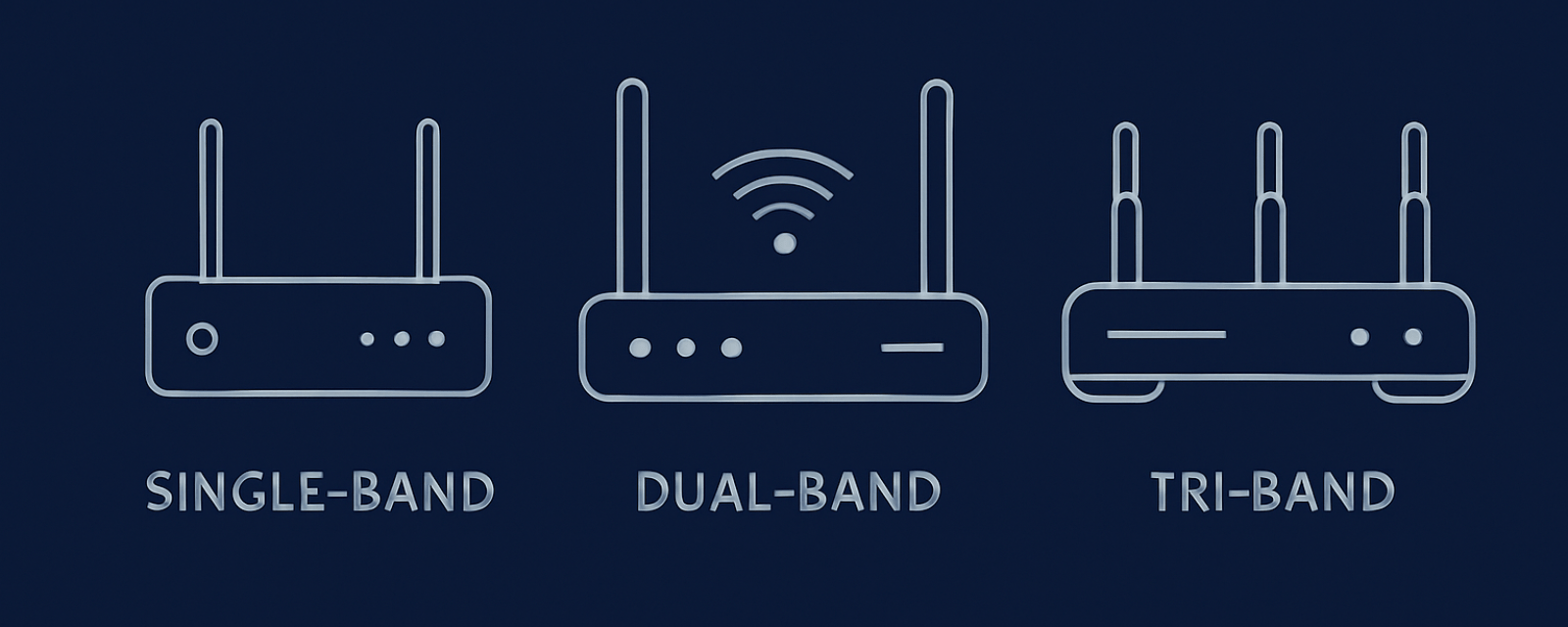Single-Band, Dual-Band, and Tri-Band Wi-Fi Routers: What’s the Difference and Which One Should You Choose?

In today’s fast-paced digital world, having a reliable Wi-Fi router is essential for seamless internet access across multiple devices. Whether you’re streaming, gaming, or working from home, choosing between single-band, dual-band, and tri-band routers can significantly impact your experience. This guide breaks down the differences, helping you select the best router for your needs.
At Ethernet Xpress, we often explain the basics of single-band routers to our customers.
What Are Single-Band Routers?
Single-band routers operate exclusively on the 2.4 GHz frequency band, making them a budget-friendly option for basic internet usage. These routers are ideal for tasks like browsing, emailing, and streaming in standard definition.
Advantages:
- Affordable: Single-band routers are cost-effective and perfect for users with simple connectivity requirements.
- Wide Compatibility: They work with older devices that may not support 5 GHz or newer Wi-Fi standards.
Limitations:
- Interference Issues: The 2.4 GHz band is crowded with household devices like microwaves and Bluetooth gadgets, which can slow down performance.
- Lower Speeds: They aren’t suitable for high-bandwidth activities like HD streaming or online gaming.
Ethernet Xpress recommends dual-band routers for most households due to their balance of speed and reliability.
Dual-Band Routers: The Best for Everyday Use
Dual-band routers support both the 2.4 GHz and 5 GHz bands, offering faster speeds and improved performance. The 5 GHz band is less congested, making it ideal for gaming, video conferencing, and HD streaming.
Advantages:
- Enhanced Speed: The 5 GHz band provides faster data transfer rates, reducing lag during high-bandwidth tasks.
- Versatility: Dual-band routers efficiently distribute network load between two bands, supporting multiple devices.
Limitations:
- Limited Range for 5 GHz: The 5 GHz band has a shorter range and struggles to penetrate walls in larger homes.
At Ethernet Xpress, we often recommend tri-band routers to customers managing smart home ecosystems or heavy streaming requirements.
Tri-Band Routers: Perfect for Smart Homes and High-Demand Users
Tri-band routers are designed for heavy internet users and smart homes with numerous connected devices. They feature one 2.4 GHz band and two 5 GHz bands or, in newer models, a 6 GHz band for cutting-edge performance.
Advantages:
- Optimal Load Distribution: With three bands, tri-band routers prevent congestion, ensuring fast and stable connections for all devices.
- Future-Proof: Ideal for households with smart home setups or high-density networks.
Limitations:
- High Cost: These routers are more expensive, making them less appealing for basic users.
- Complex Setup: Advanced features may require technical knowledge.
Ethernet Xpress helps users daily in choosing routers tailored to their home, device count, and browsing behavior—here’s how we guide them.
How to Choose the Right Wi-Fi Router for Your Needs
When selecting a router, consider these factors:
- Internet Speed
- If your ISP provides speeds above 100 Mbps, avoid single-band routers. A dual-band or tri-band router is better for maximizing your internet plan’s potential.
- Usage Patterns
- For basic tasks like browsing or emailing, a single-band router is sufficient.
- For 4K streaming, online gaming, or multi-device setups, go for a dual-band or tri-band router.
- Home Size
- In larger homes, the range limitations of the 5 GHz band can affect coverage. Consider a tri-band router or a mesh system for consistent connectivity.
- Number of Devices
- More devices mean more bandwidth demand. Tri-band routers handle device-heavy networks with ease.
- Budget
- While tri-band routers offer superior performance, dual-band routers provide a cost-effective balance of speed and coverage for most users.
Single-Band vs. Dual-Band vs. Tri-Band: A Quick Comparison Table
Feature | Single-Band Router | Dual-Band Router | Tri-Band Router |
Coverage | Larger range, slower speeds | Moderate range, better speeds | Optimal for large homes, high speeds |
Speed | Limited to 2.4 GHz, slower | Faster with 2.4 GHz and 5 GHz | Additional 5 GHz or 6 GHz along with the 2.4 GHz for top speeds |
Interference | High due to crowded 2.4 GHz | Reduced with 5 GHz band | Minimal, even in high-traffic areas |
Best For | Basic browsing, emailing | Families or small teams | Smart homes, heavy gaming/streaming |
Price | Budget-friendly | Mid-range | Premium-priced |
Advanced Wi-Fi Technologies to Consider
In addition to bands, modern routers include features that enhance performance:
- Wi-Fi Standards (Wi-Fi 6 & Wi-Fi 6E): These improve speeds, support more devices, and reduce interference.
- MU-MIMO Technology: Enables simultaneous communication with multiple devices for better efficiency.
- Beamforming: Strengthens Wi-Fi signals in specific directions for better range.
- Mesh Systems: Ideal for eliminating dead zones in large homes by providing consistent coverage.
If your devices support Wi-Fi 6 or Wi-Fi 6E, consider upgrading to a compatible router to future-proof your network. At Ethernet Xpress, we believe that matching your router to your digital lifestyle is key to an uninterrupted internet experience.
Finding the Perfect Router for Your Home
Understanding the differences between single-band, dual-band, and tri-band routers is key to optimizing your home network. Whether you’re a casual internet user or managing a smart home with dozens of connected devices, your choice of router impacts speed, coverage, and overall performance.
Evaluate your needs, home size, and budget to make an informed decision. For faster speeds, better connectivity, and future-proofing, consider a dual-band or tri-band router with the latest Wi-Fi technology.
Got a new router or planning to buy one? Pair it with the perfect broadband plan. Click on www.expl.in to discover a plan that works as hard as you do or give us a call at 08326637000 today.
Sources:
https://www.tataplayfiber.com/blog/single-band-dual-band-and-tri-band-wi-fi-routers-whats-difference
https://www.wi-fi.org/discover-wi-fi
https://www.cisco.com/c/en/us/products/wireless/what-is-mu-mimo.html
https://info.support.huawei.com/info-finder/encyclopedia/en/Beamforming.html
Recent Articles
Wi-Fi Router Buying Guide: Choosing the Best Router for Your Needs In today’s connected world,
Wi-Fi Generations Explained: From Wi-Fi 0 to Wi-Fi 7
Wi-Fi Generations Explained: From Wi-Fi 0 to Wi-Fi 7 Wi-Fi technology has evolved significantly over
The Future of Internet Technology: Top 10 Trends to Watch in 2025 In Goa, 2025,
Mesh Router Systems: The Ultimate Solution for Seamless Wi-Fi Coverage In today’s connected world, a
10 Reasons Why Ethernet Xpress is the Best Internet Service Provider (ISP) in Goa In






